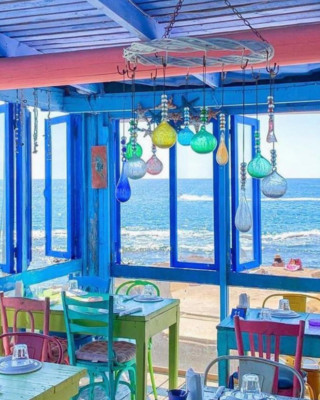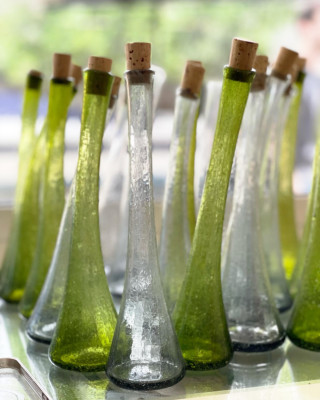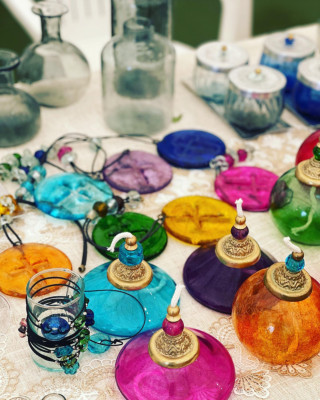Blown Glass
 Lebanese blown glass is deeply rooted in the country’s history and stands as an element of living heritage, a precious expression of human creativity. According to the archaeologist Maha Al-Masri, “glass was invented either in Sumerian territory or in Egypt, but it was developed completely in Egypt around the year 4000 BC. However, around the year 50 BC, the Phoenicians introduced the technique of the “glass cane”, or the glass tube, thus revolutionized the work of glass. This allowed the creation of unlimited shapes and objects, reducing costs and speeding up production.” As great navigators, the Phoenicians spread this technique across the Mediterranean.
Lebanese blown glass is deeply rooted in the country’s history and stands as an element of living heritage, a precious expression of human creativity. According to the archaeologist Maha Al-Masri, “glass was invented either in Sumerian territory or in Egypt, but it was developed completely in Egypt around the year 4000 BC. However, around the year 50 BC, the Phoenicians introduced the technique of the “glass cane”, or the glass tube, thus revolutionized the work of glass. This allowed the creation of unlimited shapes and objects, reducing costs and speeding up production.” As great navigators, the Phoenicians spread this technique across the Mediterranean.
 Today, artisans and workshops in Sarafand and Beddawi (Tripoli) continue making hand-blown glass, preserving techniques passed down through generations. The process is delicate and intricate and demands adeptness in managing heat and controlling ambient temperature. Using a large hollow metal rod, a hot, molten ball of glass is pulled out of the furnace. The glassblower then blows into the tube to create a luminescent bubble made from the ball that was just taken out of the oven. A few seconds later, the stem is slowly turned to mold the glass into a bulbous shape. With a second breath, the artisan can give shape to a red and hot drop. He then puts it in an old iron mold and the glass is finally removed from the metal rod. Subsequently, the glassblower grabs the freshly worked glass with large tongs, shapes it with an iron machine, and removes any excess. A second firing is then carried out at a lower temperature to solidify the glass into its final form.
Today, artisans and workshops in Sarafand and Beddawi (Tripoli) continue making hand-blown glass, preserving techniques passed down through generations. The process is delicate and intricate and demands adeptness in managing heat and controlling ambient temperature. Using a large hollow metal rod, a hot, molten ball of glass is pulled out of the furnace. The glassblower then blows into the tube to create a luminescent bubble made from the ball that was just taken out of the oven. A few seconds later, the stem is slowly turned to mold the glass into a bulbous shape. With a second breath, the artisan can give shape to a red and hot drop. He then puts it in an old iron mold and the glass is finally removed from the metal rod. Subsequently, the glassblower grabs the freshly worked glass with large tongs, shapes it with an iron machine, and removes any excess. A second firing is then carried out at a lower temperature to solidify the glass into its final form.
 In Sarafand, this time-honored profession has been handed down through the Khalife family for centuries, with children typically beginning their training around the age of 11. To this day, their ancient glassworks facility employs a furnace that dates back 2000 years to the Phoenician era. Across generations, the family has preserved techniques, secrets, tools, and artistic methods. Unfortunately, due to the influx of inexpensive imported glass and waning interest in traditional processes, most of the Khalife family’s glass workshops have closed.
In Sarafand, this time-honored profession has been handed down through the Khalife family for centuries, with children typically beginning their training around the age of 11. To this day, their ancient glassworks facility employs a furnace that dates back 2000 years to the Phoenician era. Across generations, the family has preserved techniques, secrets, tools, and artistic methods. Unfortunately, due to the influx of inexpensive imported glass and waning interest in traditional processes, most of the Khalife family’s glass workshops have closed.
In Beddawi, glass fragments resulting from explosions are recycled to craft carafes and jars. The broken pieces of glass are sifted to separate them from pebbles and sand before being transported to the kiln. A skilled glassblower then shapes the pliable dough into large jars or iconic domed carafes with slender necks that are typical of Lebanese craftsmanship.

